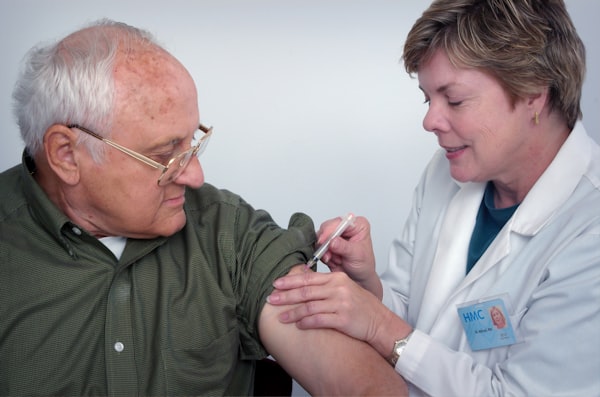Is Frontotemporal Dementia the Same as Lewy Body Dementia?

Dementia is a broad term given to a group of diseases that affect the brain. There are many different types, but two common ones are frontotemporal dementia (FTD) and Lewy body dementia (LBD). In this guide, we will explore these two forms of dementia—what sets them apart, what they share in common, and what treatments and support are available for those affected by them. Furthermore, we will discuss ways to promote early detection and diagnosis for both FTD and LBD.
We hope that this guide can help provide clarity around the two diseases, giving those living with either type of dementia (as well as their family, caregivers, and healthcare practitioners) a better understanding of their condition and how best to manage it.
What is Frontotemporal Dementia?
Frontotemporal dementia (FTD) is a type of dementia that affects the frontal and temporal lobes of the brain. It is the second most common form of dementia in younger adults, occurring in people aged 40-70 years old. The most common symptoms of FTD are changes in social and physical behavior, personality, and language.
Causes and Risk Factors of FTD
The exact cause of FTD is unknown, but it has been linked to changes in certain proteins, called tau or TDP-43, in the brain. It may also be caused by genetic factors, though this is less common.
Risk factors for developing FTD include age (over 40), family history of dementia, and having a history of head injury or stroke.
How is FTD Diagnosed?
FTD is diagnosed through a combination of tests including a complete medical history, physical exam, mental status test, blood tests, MRI or CT scans, and lumbar puncture. These tests can help rule out other types of dementia such as Alzheimer’s or Parkinson’s disease.
A neurologist or psychiatrist may also perform neuropsychological tests to assess cognitive functioning and behaviour. A genetic test may also be requested if there is a suspicion of a genetic cause.
Once all of these tests have been completed, a diagnosis of FTD can be made. Early diagnosis allows for earlier intervention and better management of the condition.
What is Lewy Body Dementia (LBD)?
Lewy Body Dementia (LBD) is a progressive neurological disorder caused by the buildup of protein deposits, known as Lewy bodies, in the brain. These deposits interfere with communication between nerve cells, leading to a various range of cognitive and motor symptoms.
LBD is the second most common type of dementia after Alzheimer’s, affecting an estimated 1.4 million people in the US alone. It is estimated that around 10-15 percent of dementia cases worldwide are due to LBD.
Causes and Risk Factors of LBD
The cause of LBD is unknown, although there is some evidence that it may be genetic. However, certain factors can increase the risk of developing LBD, including: age (over 65 years old), family history of dementia and lifestyle choices such as smoking and heavy drinking.
How is Lewy Body Dementia Diagnosed?
LBD is often difficult to diagnose because its symptoms are similar to those of other conditions, such as Alzheimer’s or Parkinson’s. Diagnosis usually involves a combination of medical testing, such as blood tests, physical exams, cognitive assessments, and brain imaging (CT scan or MRI). The doctor will also take into account the patient's medical history and any changes in symptoms over time.
Overview of Symptoms
When it comes to the symptoms of frontotemporal dementia (FTD) and Lewy body dementia (LBD), there are some similarities and a few key differences. Both are progressive degenerative neurological disorders that cause changes in behavior, memory, thinking, language, and movement.
The common symptoms of both FTD and LBD include confusion, memory problems, impaired reasoning, and difficulty controlling emotions and behavior. They also share visual hallucinations and mood swings as possible symptoms.
However, there are some specific signs that differentiate between FTD and LBD. People with FTD may display a lack of empathy, an inability to recognize inappropriate behavior, compulsive behaviors or rituals, and difficulty speaking and understanding language. Those with LBD may experience issues with balance and coordination, episodes of stiffening of the muscles (called rigidity), and tremors.
In some cases, these two types of dementia have overlapping or even identical symptoms. It's important for family members and caregivers to be aware of any signs they notice in their loved one, so they can get the right diagnosis and tailor appropriate treatment and care.
Treatment Options for Frontotemporal Dementia and Lewy Body Dementia
When it comes to treating Frontotemporal Dementia (FTD) and Lewy Body Dementia (LBD), there are many options available. It’s important to understand, however, that both of these forms of dementia have different effects on the brain, and therefore different treatments may work better for one than the other. It’s also important to ensure there are no interactions with any existing medications or conditions when considering the best treatment options. With that in mind, let’s take a look at some of available treatments for FTD and LBD.
Treatments for LBD
- Medication: Medications such as cholinesterase inhibitors and dopamine agonists can help slow the progression of symptoms and improve quality of life.
- Behavioral therapy: This type of therapy can help manage behavioral issues such as aggression, mood swings, and sleep disturbances.
- Occupational therapy: Occupational therapy can help address changes in physical ability and cognition, and is especially helpful for those who wish to continue to work or maintain their independence.
Treatments for FTD
- Prescription medications: A variety of medications can help manage behavioral symptoms associated with FTD, such as depression, anxiety, and agitation.
- Therapy: Cognitive Behavioral Therapy (CBT) can help manage emotional problems, while family therapy can help improve communication and problem-solving.
- Supportive care: Professional caregivers or family members can provide assistance with daily activities, such as bathing, dressing, and eating, as well as emotional support and comfort.
No matter which form of treatment is chosen, it’s important to always consult with a doctor to ensure it is the best option for your individual situation.
Coping Tips for Family Members and Caregivers
Caring for a loved one with dementia is a challenging task. Families and caregivers must balance providing their loved one with the care they need while taking care of their own well-being. Fortunately, there are ways to manage these competing demands.
Understand Your Loved One’s Diagnosis
A key factor in providing effective care is gaining a better understanding of your loved one’s diagnosis. Take time to research Frontotemporal Dementia (FTD) and Lewy Body Dementia (LBD) and the differences between them. Educated yourself about the signs, symptoms, and stages of both illnesses and reach out for advice from knowledgeable professionals. Through this knowledge, you will be able to provide more effective and tailored care for your loved one.
Practice Self-Care
It’s impossible to care for a loved one suffering from dementia if you do not also take care of your own well-being. Dedicate time and energy to activities and endeavors that bring you joy, nourish your body, and nurture your spirit. Whether it’s a relaxing bath, taking a leisurely stroll, or simply binge-watching your favorite show, having this “me-time” will make you better equipped to provide care.
Set Boundaries and Have Realistic Expectations
Set realistic and achievable expectations for the role you will play in caring for your loved one. Understand that you can’t do it all yourself and set boundaries for what you’re willing – and not willing – to do. This doesn’t mean you don’t care; it just means that you recognize your own limits. Instead, focus on doing what you can manage, without compromising your own health and safety.
Create a Support Network
Realize that you don’t have to shoulder the burden of care alone. Build a trusted network of family members, loved ones, and professionals who can assist you and provide emotional support. By placing value on this support and engaging with it regularly, you will have a stronger foundation to provide quality care for your loved one.
Stay Positive
It is important to maintain a positive attitude when caring for a loved one with dementia. Although it can be a difficult process, try to focus on the moments that bring joy instead of focusing on the illness constantly. By being positive, you can provide much needed emotional support for your loved one.
Seek Professional Help
When caring for a loved one with either FTD or LBD, it is important to consult a healthcare professional. A trained doctor or specialist can provide you with advice and support regarding the best ways to manage the condition and provide quality care. If you are struggling to control the situation or find it too emotionally challenging, do not hesitate to seek professional help.
Discussing Diagnosis with a Doctor
When talking to your doctor about FTD or LBD, it is important to be prepared. It is understandable to have lots of questions and concerns, and to want to learn as much as you can about these two types of dementia. Here are some tips for discussing diagnosis with your doctor:
- Be prepared with a list of questions. Write down a few key questions you would like to ask your doctor about the diagnosis of either FTD or LBD. This will ensure that you don’t forget to ask something important during your appointment.
- Take notes. It can be helpful to bring a notepad and take notes throughout your appointment, so that you can remember all of the information your doctor provides. Alternatively, you could bring a friend or family member with you who can help you take notes and provide support.
- Don’t be afraid to ask questions. If you don’t understand something, or need some clarification, don’t hesitate to ask. It is important that you feel able to understand what your doctor is telling you.
- Ask about treatment options. It is essential to know what treatments are available for the types of dementia you may have, so that you can make an informed decision about which course of action to take. You should ask about any potential side effects or interactions that might occur when taking medications or supplements.
- Seek support. If you need extra help or just someone to talk to, look for support from family and friends or seek out support groups or counseling services.
It can also be helpful to do some research ahead of time by looking up information online and reading books and articles on the subject. The more knowledge you have, the better equipped you’ll be to discuss diagnosis with your doctor.
Early detection is key when it comes to dementia. Regular checkups and testing can quickly identify signs of FTD or LBD, allowing for treatment and support to start as soon as possible.
Currently, there are a range of tests used for diagnosing each type of dementia, such as cognitive testing, physical exams, and brain scans. For FTD, genetic testing may also be recommended by a doctor to help confirm the diagnosis.
Cognitive testing is used to measure memory, problem solving, language skills, and other areas of mental functioning. Physical exams will look at the health of the patient, including signs of movement disorders which can be linked to certain types of dementia. Using imaging techniques such as MRI scans, doctors can scan the brain in order to look for any changes or damage which could indicate a diagnosis of FTD or LBD.
It’s important to remember that no single test can confirm a diagnosis of dementia. Instead, a combination of tests can give a more accurate picture and allow for earlier diagnosis. Early diagnosis is essential for providing effective support and treatments, so make sure to talk to your doctor if you are concerned about any changes in your or a loved one’s behaviour.
Differential Diagnosis
When diagnosing either Frontotemporal dementia (FTD) or Lewy Body dementia (LBD), it’s important to remember that there are other conditions or diseases with similar symptoms. Some of these include Alzheimer’s disease, Parkinson’s disease, and vascular dementia. In order to rule these out as possible causes of the patient’s symptoms, doctors may use different assessment tools or tests.
Alzheimer’s is caused by the build-up of abnormal proteins in the brain, leading to problems with thinking, memory, and speech. Parkinson’s disease is associated with a loss of nerve cells that produce dopamine, resulting in difficulty with movement. Vascular dementia is the result of decreased blood flow to the brain due to narrowed arteries, causing issues with cognitive abilities including memory, language, and decision making.
Using a range of diagnostic tools such as patient history, physical exams, cognitive tests, imaging scans, and laboratory tests, doctors will be able to determine if the patient’s symptoms are caused by FTD or LBD, or one of the other conditions.
Overview of Prognosis
When considering the prognosis for frontotemporal dementia (FTD) and Lewy body dementia (LBD), it is important to understand that life expectancy can vary significantly depending on the individual. It is also important to note that when an individual is diagnosed with either of these dementias, they can expect to experience a marked decline in their quality of life.
In general, studies have demonstrated that people diagnosed with FTD have a median lifespan of about eight to ten years from diagnosis. However, some individuals have been known to live more than fifteen years after diagnosis. On the other hand, LBD has an average expected prognosis of only three to four years from diagnosis. In severe cases, though, this time frame can be considerably shorter.
The prognosis for FTD and LBD is greatly dependent on how quickly they are diagnosed and treated. A quick diagnosis and early intervention can help to slow the progression of symptoms as well as improve the quality of life for those living with a diagnosis.
For family members and caregivers of those diagnosed with dementia, it is important to remember that everyone’s experience with these conditions is unique and that there is no one-size-fits-all approach. It is imperative to focus on helping the individual remain as independent as possible for as long as possible.
Finding reliable advice and support from those who understand what you're experiencing is vital when caring for someone with dementia. There are many organizations, websites, and other resources that provide helpful information and emotional support.
If you or a loved one is living with frontotemporal dementia (FTD) or Lewy body dementia (LBD), there are several resources available to help. Here are some of the organizations and websites that can provide guidance:
• The Alzheimer’s Association: The Alzheimer's Association is the world's leading voluntary health organization in Alzheimer's care, support and research. They have numerous resources for caregiving, including their 24/7 helpline and online information about dementia, treatment research, and more.
• The Lewy Body Dementia Association: The Lewy Body Dementia Association offers valuable information on Lewy body dementia, including symptom management, caregiving strategies, and research updates.
• American Brain Foundation: The American Brain Foundation supports research and provides resources for brain diseases, including FTD and LBD. They have a library of resources, patient education materials, and educational videos.
• The Association for Frontotemporal Degeneration: The Association for Frontotemporal Degeneration provides information about FTD, caregiving tips, and research news.
• The National Institute of Aging: The National Institute of Aging provides a wealth of information on healthy brain aging, Alzheimer's and other types of dementia, and resources for families.
These organizations and websites can be excellent sources of support and information about FTD and LBD. It's important to remember that no two cases of dementia are alike, so it's always best to speak with your doctor about any questions or concerns related to your individual condition.
In conclusion, both frontotemporal dementia (FTD) and Lewy Body dementia (LBD) are progressive neurological disorders that can cause debilitating symptoms. Although these two forms of dementia have some similarities, they are separate conditions with different causes and treatments. It is important to get a timely diagnosis and the right treatment in order to give the person the best chance of managing their symptoms and maintaining a quality of life as long as possible. Resources such as support groups, websites, and medical professionals can help families and caregivers cope with the challenges of living with FTD or LBD. Early detection of either of these dementias is also incredibly important and should be discussed with a doctor if any of the signs and symptoms are present.
You might also like this article:







